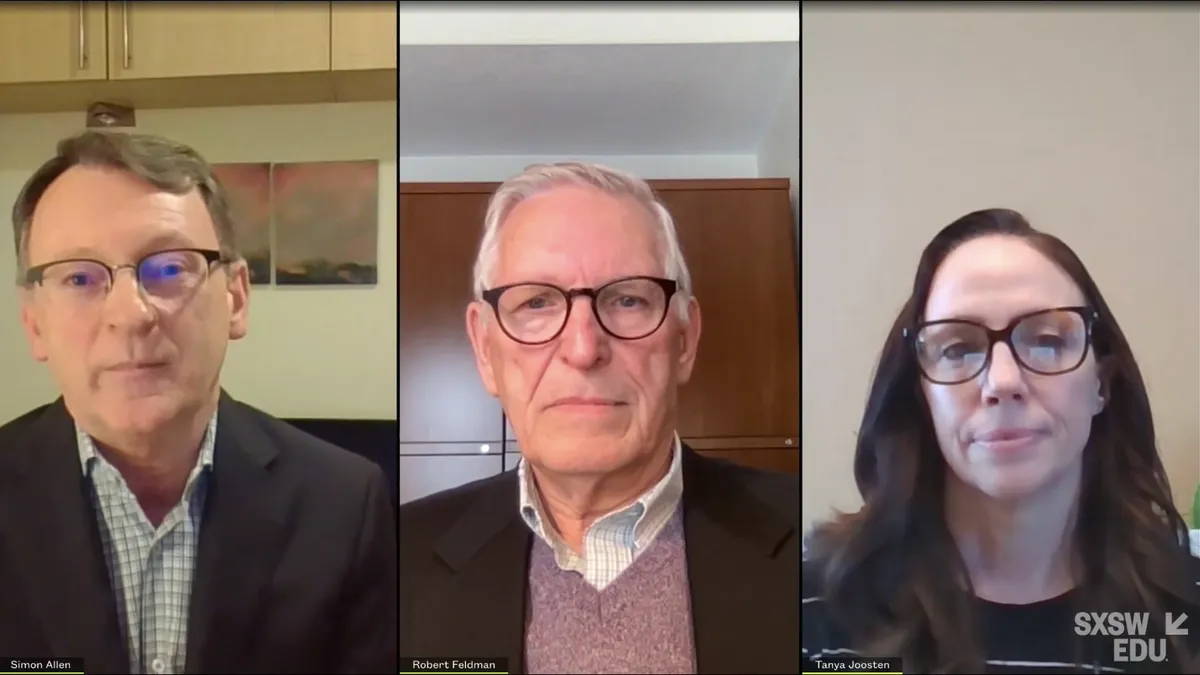When the COVID-19 pandemic shuttered schools in March 2020 and forced an emergency transition to virtual learning, there was little-to-no time to think about strategy or to prepare educators and students alike for a model they had likely never used before. But now that the genie is out of the bottle and investments have been made, figuring out how to better utilize the medium in the future is an imperative for K-12 school leaders.
In a Tuesday virtual session during the SXSW EDU conference, McGraw-Hill CEO Simon Allen moderated a discussion of how learning science can improve K-12 distance education models with Robert Feldman of the University of Massachusetts Amherst and Tanya Joosten of the University of Wisconsin-Milwaukee.
Joosten said that prior to the pandemic, we thought the digital divide was being closed because more people seemingly had access to internet and mobile devices and data, but the sudden transition to remote instruction highlighted how wide that gap still was.
Despite challenges, there are examples of success throughout the country, even among marginalized or disadvantaged students, that serve as "anomalies" to be studied and shared for best practices on improving delivery and performance in virtual environments.
Feldman, who serves as senior advisor to the chancellor and professor of psychological and brain sciences at UMass Amherst, said the pandemic presented K-12 with a “perfect storm” of inequity.
With past major crises like the Great Depression, the AIDS epidemic and the 2008 recession, Feldman said, minority communities were impacted far more than more affluent ones. Likewise, many marginalized students are experiencing digital poverty, alongside a lack of access to materials and space to study. This makes it much harder for students of color and low-income students broadly to engage in online learning but, he added, they’re also more likely to be online than face-to-face compared to their more affluent peers.
“It’s incumbent on us to think of ways we can support these communities,” Feldman said, noting schools were forced to engage in online learning on an emergency basis without time to think through it and train students or faculty for the format.
Joosten, who serves as director of digital learning research and development and co-director of the National Research Center for Distance Education and Technological Advancements at UW-Milwaukee, added that just because students may have some tech skills or familiarity, that doesn’t necessarily translate to being able to work online. Having access to tech, a place to study, and the organizational, time-management and self-direction skills to succeed in an online environment is critical, she said.
“We know digital natives are a myth,” Joosten said, noting students also are having to learn how to communicate in new ways with peers and teachers, and that they are lacking the social-emotional aspect of learning because it’s hard to make school fun and social in this environment.
Meanwhile, Feldman suggested students are ending up with less social support because of higher social media usage, which Joosten said becomes an equity issue, as certain racial and ethnic groups prefer more personal forms of socialization over digital communication.
The teaching community has also struggled.
Feldman used college professors he knows as an example, saying they’re teaching in a way they never expected to, and many had fairly negative ideas about teaching online to begin with. Instructors who are used to being experts are now in a situation where they’re novices and learning how to use this medium as they go.
Parents also are now more involved in their kids’ learning, leading to anxiety and depression, as well. “Usually where you see people acclimating to stressors, people are showing higher levels of stress than a year ago,” he said.
Transforming online learning
Ultimately, Allen asked the pair of experts how educators can transform from this emergency structure to a more cerebral, thoughtful approach to online learning.
Joosten said the challenge for teachers is that a lot of them don’t know how teach online or design classes effectively for the medium, and robust professional development isn’t in place. What many are finding is replicating what works face-to-face in an online environment doesn’t work as well.
She suggested administrators take advantage of research from organizations like DETA, Quality Matters, Educause and others. Pedagogy must come first, technology comes second, and thinking more strategically will be critical moving forward, she said.
Additionally, she recommended providing time for teachers and faculty to learn strategies on effectively using blended and hybrid learning pedagogy models. Educators should also think about what they want students to be able to demonstrate and do at the end of the semester and design learning backward from there, she said, with consideration given to what should be kept face-to-face and what doesn't need to be.
Feldman echoes that sentiment. “Basically, good teaching is good teaching” and it doesn’t matter if it’s online or face to face, he said. Educators know what makes good teaching and can apply it, but he reiterated that students must also be taught how to take online courses and engage in them.




















